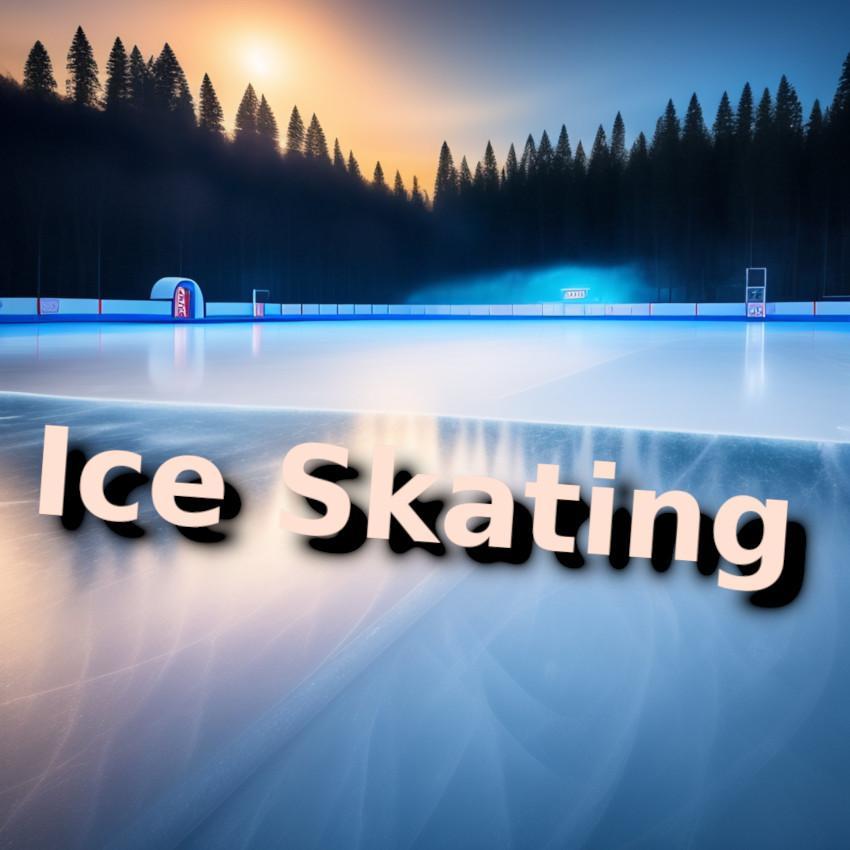


Ice skating is not just a winter pastime; it's a graceful and exhilarating activity that combines athleticism with artistic expression. Whether you're a beginner or an experienced skater, this comprehensive guide aims to provide insights into the world of ice skating, offering useful tips to enhance your skills and enjoyment on the ice.
The Magic of Ice Skating:
Ice skating has a timeless appeal, from the elegant spins and jumps of figure skating to the fast-paced excitement of ice hockey. It's a sport that embraces creativity, athleticism, and the sheer joy of gliding effortlessly across the ice.
Choosing the Right Skates:
The first step in your ice skating journey is selecting the right pair of skates. Visit a reputable skate shop to get properly fitted for skates that match your foot size and shape. Consider whether you prefer figure skates or hockey skates, as each serves a different purpose.
Mastering the Basics:
For beginners, mastering the basics is crucial. Start with learning how to balance on the ice, march in place, and glide forward. Practice marching and gliding along the boards until you feel comfortable with the sensation of being on skates.
Proper Warm-Up and Stretching:
Like any physical activity, ice skating requires a proper warm-up. Spend a few minutes doing light aerobic exercises to increase blood flow to your muscles. Perform gentle stretches to prepare your legs, ankles, and core for the movements involved in skating.
Falling Safely:
Falls are a natural part of learning to skate. Knowing how to fall safely can prevent injuries. When you feel yourself losing balance, bend your knees, relax your body, and try to fall to the side rather than backward. Practice getting up from a fall to build confidence.
Building Confidence with Balance Exercises:
Enhance your balance by incorporating specific exercises into your routine. Practice standing on one foot, perform squats, and work on your core strength. Improved balance will translate into better control and stability on the ice.
Skating Forward and Backward:
Once you've mastered the basics, progress to skating forward. Push off with one foot, glide, and then transfer your weight to the other foot. Practice controlled strides and turns. As you become more comfortable, challenge yourself by learning to skate backward.
Turning Techniques:
Mastering turning techniques adds fluidity to your skating. Practice simple turns, such as the two-foot turn and the crossover turn. These maneuvers not only enhance your skills but also contribute to the aesthetics of your skating.
Edge Control and Stopping Techniques:
Understanding edge control is essential for maneuvering on the ice. Practice shifting your weight to the inside or outside edges of your skates. Learn different stopping techniques, such as the snowplow stop or the hockey stop, to gain control during your skating sessions.
Introduction to Figure Skating or Hockey Skills:
Depending on your interests, consider exploring figure skating or hockey skills. Figure skating focuses on elegant jumps, spins, and choreography, while hockey skills emphasize speed, agility, and precision. Take lessons or join a program tailored to your chosen discipline.
Safety Precautions:
Prioritize safety while ice skating. Wear appropriate protective gear, including a helmet and padding if needed. Be aware of your surroundings, adhere to rink rules, and avoid engaging in maneuvers beyond your skill level to minimize the risk of injuries.
Enjoying the Journey:
Finally, embrace the joy of ice skating. Whether you're twirling gracefully on figure skates or dashing across the ice with a hockey stick, savor the experience. Join skating clubs, participate in themed events, and share the ice with fellow enthusiasts to enrich your skating journey.
Ice skating is a fun and challenging sport that offers many opportunities for individuals of all ages and skill levels. Here are some examples of the opportunities that ice skating can provide:
Recreational skating: Many ice rinks offer public skating sessions for people who want to skate for fun and exercise.
Competitive figure skating: Figure skating is a sport that involves performing jumps, spins, and other elements on ice. Competitions are held at various levels, from local to international.
Ice hockey: Ice hockey is a team sport played on ice. Players wear skates and use sticks to shoot a puck into the opposing team's net. Hockey is a popular sport in many countries and offers opportunities for both amateur and professional players.
Speed skating: Speed skating is a competitive sport in which skaters race against each other on a long track of ice. Speed skating competitions can be held indoors or outdoors, and athletes can compete at various levels.
Ice shows: Ice shows are performances that feature professional skaters performing choreographed routines on ice. These shows can be seen in person or on television and offer opportunities for skaters to showcase their skills and creativity.
Coaching and teaching: Skaters who have advanced skills and experience may choose to become coaches or instructors. This provides an opportunity to share their knowledge and passion for ice skating with others.
There are several types of ice skating rinks, including:
Indoor ice rinks: These are ice rinks that are located indoors and are typically found in arenas or sports facilities.
Outdoor ice rinks: These are ice rinks that are located outside and are typically only open during the winter months. They can be natural ice rinks or man-made rinks.
Natural ice rinks: These are ice rinks that are formed by nature, such as lakes, ponds, and rivers.
Man-made ice rinks: These are ice rinks that are created using refrigeration technology to freeze water into a smooth surface suitable for skating.
Roller skating rinks: These are indoor or outdoor rinks that are designed for roller skating rather than ice skating. They typically have a hard, smooth surface that is similar to an ice rink.
Synthetic ice rinks: These are rinks made of a special type of plastic that simulates the feeling of skating on ice. They can be used both indoors and outdoors.
Portable ice rinks: These are small, temporary rinks that can be set up and taken down quickly. They are often used for events or parties.
Olympic-size ice rinks: These are larger ice rinks that meet the standard dimensions for Olympic ice skating competitions. They are typically 30 meters wide by 60 meters long.
Figure skating is the most popular ice skating sport worldwide. It is a form of competitive and artistic ice skating that involves performing a variety of jumps, spins, and dance-like movements to music. Figure skating competitions are held at various levels, including local, national, and international levels, with the most prestigious being the Olympic Games.
Figure skating is also popular as a recreational activity, with many people enjoying skating for fun and exercise. In addition to figure skating, other popular ice skating sports include speed skating, ice hockey, and synchronized skating. Each of these sports has its own unique rules and techniques, and all require a great deal of skill and practice to master.
Ice hockey is a very popular ice skating sport around the world, particularly in Canada, the United States, Russia, Sweden, Finland, and the Czech Republic. It is a team sport that is played on an ice rink with two teams of six players each (including a goalkeeper) trying to score goals by shooting a puck into the opposing team's net using a stick.
Ice hockey requires a combination of speed, strength, agility, and teamwork. It is a physically demanding sport that involves a lot of contact between players, which is why protective gear is worn, including helmets, shoulder pads, elbow pads, gloves, shin guards, and skates.
Ice hockey has many professional leagues and tournaments around the world, including the National Hockey League (NHL) in North America, the Kontinental Hockey League (KHL) in Russia, and the Swedish Hockey League (SHL) in Sweden. It is also played at the Olympic Games, where it is one of the most popular and watched winter sports.
Before starting activities with ice skating, there are several things you should know to ensure your safety and enjoyment:
Dress appropriately: Wear warm, comfortable clothing that allows you to move freely. It's also important to wear gloves, a helmet, and properly fitted skates.
Check the conditions: Before stepping onto the ice, check the condition of the rink. Look for any cracks or bumps, and check that the ice is thick enough to support your weight.
Learn the basics: If you're new to ice skating, it's important to learn the basic techniques such as how to stand, move forward, turn, and stop. Consider taking lessons from a qualified instructor.
Be aware of others: When skating in a public rink, be aware of other skaters around you and avoid collisions. Skate in the same direction as the other skaters and use hand signals to communicate with others.
Practice safety: Always skate within your ability level and avoid doing tricks or stunts that are beyond your skill level. Don't skate too close to the boards, and avoid carrying items or holding hands while skating.
Follow rink rules: Follow the rules of the ice rink and obey any signs or warnings posted. Don't skate when the rink is closed or when it's being resurfaced.
Take breaks: Ice skating can be physically demanding, so take frequent breaks to rest and hydrate.
Ice skating is a blend of artistry, athleticism, and pure enjoyment. By focusing on proper techniques, building confidence gradually, and staying committed to the learning process, you can elevate your ice skating skills. Whether you're seeking a leisurely glide or aiming for advanced maneuvers, the key is to enjoy the journey and let the magic of ice skating unfold before you.

We use cookies
We use cookies and other tracking technologies to improve your browsing experience on our website, to show you personalized content and targeted ads, to analyze our website traffic, and to understand where our visitors are coming from. Privacy Policy.